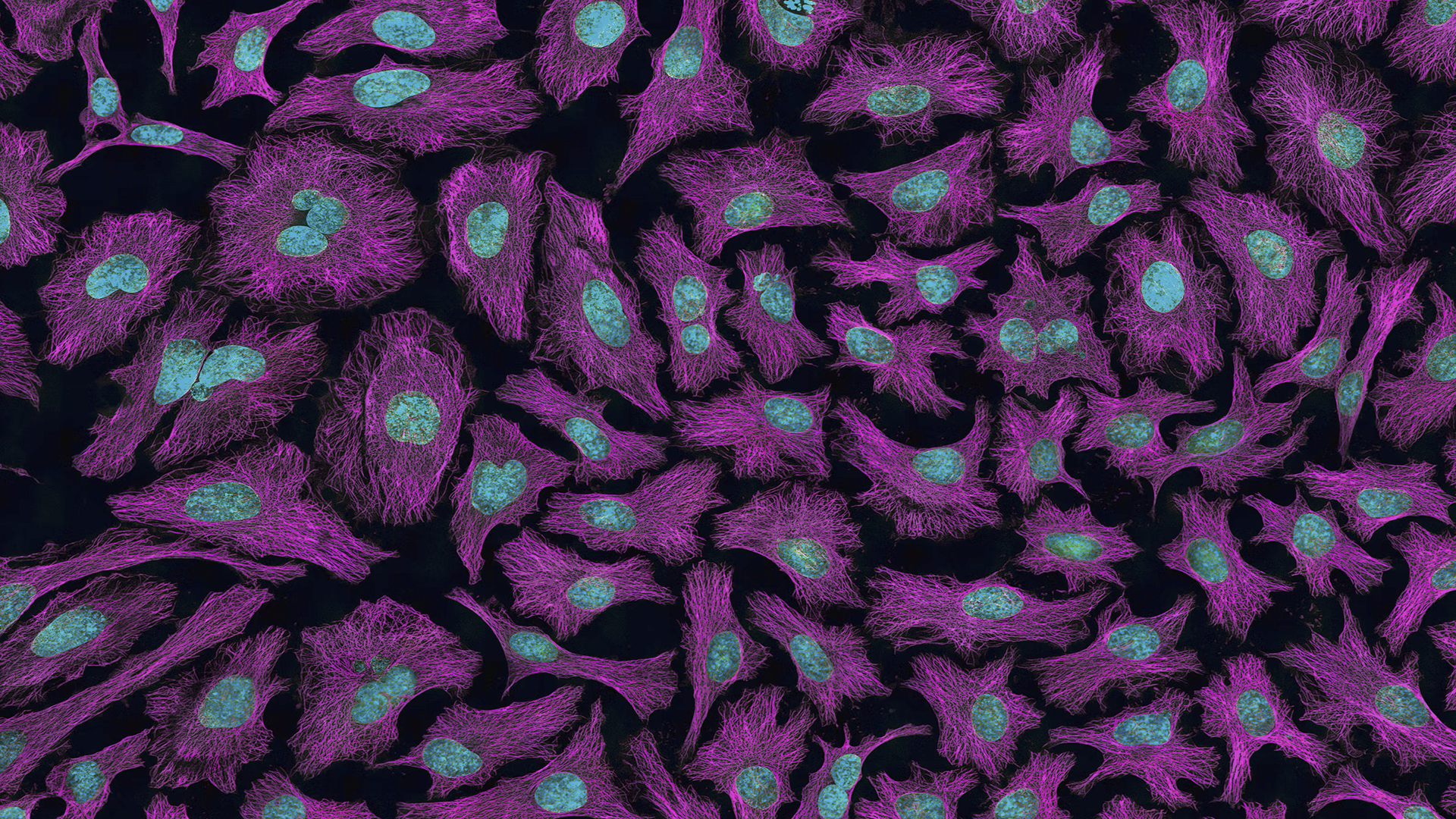Reading Time – 9 Minutes, Difficulty Level – Expert
The tissues of the human body often experience environmental stressors that alter their cellular processes. The presence or absence of oxygen is one such stressor that causes cells to quickly alter the proteins they express (Brumwell et al., 2020). Oxygen, or the lack of, is an important driver of normal metabolic and developmental processes as well as a contributing factor to maladies such as stroke, low blood pressure, heart attack, anaphylaxis, and cancer.
Hypoxia and its effect on the cell
Within the normal cellular environment, cells experience a concentration of oxygen of 2-5% (Pattappa et al., 2019). During these conditions, the cells have a homeostatic supply of O2 that allows the cell to generate energy and conduct normal cell processes (Semenza, 2013). Hypoxia, characterised by less than 1% oxygen in cells, plays a key role in altering protein synthesis to drive processes such as fetal development (Semenza, 2013). In a developing embryo, a low oxygen environment is a key driver of growth, cell differentiation, and cell migration. In addition to embryogenesis, hypoxia is implicated in the pathogenesis and progression of tumorigenic cancers (Farina et al., 2020). Throughout all stages of progression, tumour interiors are environments that exhibit the hypoxic response, and the size of the tumour is directly proportional to the number of cells experiencing hypoxia (Farina et al., 2020). Tumour hypoxia has been proven to confer additional pathogenicity to cancer and increased resistance to pharmaceutical interventions such as radiation therapy (Farina et al., 2020). Understanding the molecular mechanisms of the hypoxic response is therefore an important facet of cancer research that may lead to the development of targeted therapeutics to better treat tumorigenic cancers.
Transcriptional Control
The availability of oxygen cannot be controlled by individual cells therefore a system of oxygen sensing has evolved to quickly and effectively adapt to the absence of oxygen. Human cells contain proteins called hypoxia inducible factors (HIFs) that respond to low intracellular levels of oxygen (Semenza, 2013). HIF-1 consists of two subunits, HIF-1α and HIF-1β (Semenza, 2013). During physioxia, HIF-1α is targeted for degradation by other cellular proteins (Semenza, 2013). The reaction of HIF-1α degradation requires the availability of oxygen thus, during hypoxic conditions HIF-1α is not degraded and is stabilised within the cell to induce the hypoxic response (Farina et al., 2020). Upon hypoxia-induced stabilisation, HIF-1α enters the nucleus to dimerize (partner up) with HIF-1β (Farina et al., 2020). The full HIF-1 protein is now able to bind to hypoxia responsive elements (HREs) at specific DNA sites, triggering the transcription of many hypoxia responsive genes (Farina et al., 2020). HIF activation regulates the expression of genes involved in processes such as metabolic adaptation, angiogenesis, cellular motility, and metastatic progression of cancer (Farina et al., 2020).
The highly regulated transcriptional changes allow cells to generate a plethora of proteins specific to the hypoxic response. This facilitates increased survival during hypoxic conditions and increased pathogenicity during tumour growth.
Splicing of pre-mRNA
Prior to translation into protein molecules, mRNA molecules undergo a considerable amount of post-transcriptional modifications that confer translational control and may alter the peptide sequence. Splicing of pre-mRNA transcripts is the process of removing introns (sequences that don’t code for protein) and sometimes certain exons (sequences that code for protein) from the transcript and joining the remaining exons together (Farina et al., 2020). The process of pre-mRNA splicing is an integral aspect of mRNA maturation and is responsible for the formation of protein isoforms (proteins that are similar to one another but perform slightly different roles) and expansion of the proteome through alternative splicing (Farina et al., 2020).
Alternative splicing involves the inclusion or exclusion of different exons, yielding different mature mRNA transcripts and generating protein isoforms (Farina et al., 2020). Alternative splicing is a powerful tool that allows a single gene to code for more than one protein, allowing the number of required genes, and therefore the size of the genome, to be as condensed as possible. Translation of protein isoforms due to alternative splicing is a tightly regulated process however, it can be influenced and induced by environmental conditions such as hypoxia (Farina et al., 2020).
Alternative splicing due to hypoxia has been observed in a plethora of cell lines, and has been directly associated with tumour progression (Farina et al., 2020). Hypoxia induced alternative splicing of mRNA transcripts contributes to the pathogenesis of cancer by inducing metastasis, decreasing cell death events, increasing tumor angiogenesis, and conferring immortality to cancer cells (Farina et al., 2020).
Translational Control
The final step in the Central Dogma, translation of mRNA molecules into proteins, does not go unimpacted by a hypoxic environment although much less is known about these processes. Hypoxia has been known to prevent the main method in which mRNA molecules are translated (Liu and Simon, 2004). Most mRNA molecules are translated through a process known as “cap dependent translation” in which specific molecules bound to one end of the mRNA facilitate the initiation of translation (Liu and Simon, 2004). Hypoxic environments have been demonstrated to decrease the occurrence of this mechanism. In contrast, “cap-independent translation” may be upregulated in hypoxic cells (Liu and Simon, 2004). This shift allows for further control over gene expression and may contribute to the tumour progression behaviours seen in hypoxic cells (Liu and Simon, 2004). The mRNA molecules with the structure to allow for cap-independent translation are genes such as HIF-1 and other genes required for cell survival and proliferation (Liu and Simon, 2004). The effects of hypoxia on translational mechanisms must be studied in more depth in order to fully elucidate the impact a lack of oxygen has on this facet of gene expression.
Conclusion
Hypoxia is both a normal driver of development and an abnormal enhancer of pathogenesis in cancer. In response to low oxygen, the cell will begin the hypoxic response by altering its transcriptional and translational mechanisms to induce expression of genes specific to the hypoxic environment. Hypoxia has been deemed an important marker of cancer and has been shown to confer protection to tumour cells by way of metastasis induction, metabolic reprogramming, angiogenesis promotion, and more. Further research on hypoxia and its effect on cancerous cells is an exciting area of research that may one day lead to the development of novel therapeutics.
References
Brumwell, A., Fell, L., Obress, L., Uniacke, J. (2020) Hypoxia influences polysome distribution of human ribosomal protein S12 and alternative splicing of ribosomal protein mRNAs. RNA. 26, 361-371.
Farina, A.R., Cappabianca, L., Sebastiano, M., Zelli, V., Guadagni, S., Mackay, A.R. (2020). Hypoxia-induced alternative splicing: the 11th Hallmark of Cancer. J. Exp. Clin. Cancer Res. 39, 110.
Liu, L., Simon, M.C. (2004). Regulation of transcription and translation by hypoxia. Cancer Biol Ther. 3(6):492-7.
Pattappa, G., Johnstone, B., Zellner, J., Docheva, D., Angele, P. (2019). The Importance of Physioxia in Mesenchymal Stem Cell Chondrogenesis and the Mechanisms Controlling Its Response. Int J Mol Sci. 20, 484. Semenza, G.L. (2012). Hypoxia-Inducible Factors in Physiology and Medicine. Cell. 148, 399-408.

I’m a first year Masters student at Queen’s University, Ontario, Canada studying Immunology and Cancer, following on from completing a BSc at the University of Guelph, Ontario.
I have a passion for Molecular Biology, with a particular interest in the use of modern molecular techniques to treat and cure disease.








